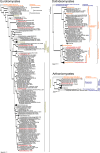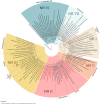Genomic features of lichen-associated black fungi
- PMID: 39710945
- PMCID: PMC11664114
- DOI: 10.1002/iub.2934
Genomic features of lichen-associated black fungi
Abstract
Lichens are mutualistic associations consisting of a primary fungal host, and one to few primary phototrophic symbiont(s), usually a green alga and/or a cyanobacterium. They form complex thallus structures, which provide unique and stable habitats for many other microorganisms. Frequently isolated from lichens are the so-called black fungi, or black yeasts, which are mainly characterized by melanized cell walls and extremophilic lifestyles. It is presently unclear in which ways these fungi interact with other members of the lichen symbiosis. Genomic resources of lichen-associated black fungi are needed to better understand the physiological potential of these fungi and shed light on the complexity of the lichen consortium. Here, we present high-quality genomes of 14 black fungal lineages, isolated from lichens of the rock-dwelling genus Umbilicaria. Nine of the lineages belong to the Eurotiomycetes (Chaetothyriales), four to the Dothideomycetes, and one to the Arthoniomycetes, representing the first genome of a black fungus in this class. The PacBio-based assemblies are highly contiguous (5-42 contigs per genome, mean coverage of 79-502, N50 of 1.0-7.3 mega-base-pair (Mb), Benchmarking Universal Single-Copy Orthologs (BUSCO) completeness generally ≥95.4%). Most contigs are flanked by a telomere sequence, suggesting we achieved near chromosome-level assemblies. Genome sizes range between 26 and 44 Mb. Transcriptome-based annotations yielded ~11,000-18,000 genes per genome. We analyzed genome content with respect to repetitive elements, biosynthetic genes, and effector genes. Each genome contained a polyketide synthase gene related to the dihydroxynaphthalene-melanin pathway. This research provides insights into genome content and metabolic potential of these relatively unknown, but frequently encountered lichen associates.
Keywords: PacBio; biosynthetic gene clusters; diversity; funannotate; melanin; phylogenetics; symbiosis.
© 2024 The Author(s). IUBMB Life published by Wiley Periodicals LLC on behalf of International Union of Biochemistry and Molecular Biology.
Conflict of interest statement
The authors declare no conflict of interest.
Figures




Similar articles
-
Prescription of Controlled Substances: Benefits and Risks.2025 Jul 6. In: StatPearls [Internet]. Treasure Island (FL): StatPearls Publishing; 2025 Jan–. 2025 Jul 6. In: StatPearls [Internet]. Treasure Island (FL): StatPearls Publishing; 2025 Jan–. PMID: 30726003 Free Books & Documents.
-
In silico search reveals the association of lichens with black yeast-like fungi in the order Chaetothyriales.Fungal Biol. 2025 Oct;129(6):101618. doi: 10.1016/j.funbio.2025.101618. Epub 2025 Jun 14. Fungal Biol. 2025. PMID: 40915677
-
The Xenopyricularia zizaniicola exhibits a genome architecture distinct to the two-speed genome.Microbiol Spectr. 2025 Jul;13(7):e0036225. doi: 10.1128/spectrum.00362-25. Epub 2025 Jun 9. Microbiol Spectr. 2025. PMID: 40488379 Free PMC article.
-
A rapid and systematic review of the clinical effectiveness and cost-effectiveness of paclitaxel, docetaxel, gemcitabine and vinorelbine in non-small-cell lung cancer.Health Technol Assess. 2001;5(32):1-195. doi: 10.3310/hta5320. Health Technol Assess. 2001. PMID: 12065068
-
The Black Book of Psychotropic Dosing and Monitoring.Psychopharmacol Bull. 2024 Jul 8;54(3):8-59. Psychopharmacol Bull. 2024. PMID: 38993656 Free PMC article. Review.
References
-
- Schwendener S. Ueber die Beziehungen zwischen Algen und Flechtengonidien. Botanische Zeitung. 1868;26:289–292.
-
- Cardinale M, de Castro JV Jr, Müller H, Berg G, Grube M. In situ analysis of the bacterial community associated with the reindeer lichen Cladonia arbuscula reveals predominance of Alphaproteobacteria . FEMS Microbiol Ecol. 2008;66:63–71. - PubMed
-
- Grube M, Cardinale M, de Castro JV Jr, Müller H, Berg G. Species‐specific structural and functional diversity of bacterial communities in lichen symbioses. ISME J. 2009;3:1105–1115. - PubMed
MeSH terms
LinkOut - more resources
Full Text Sources
Miscellaneous

